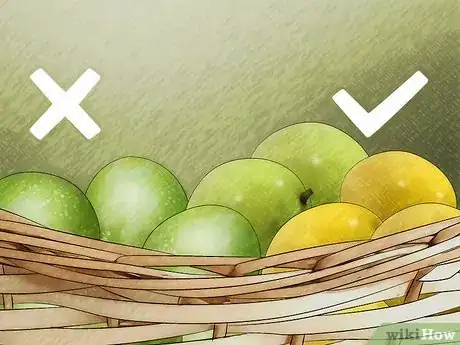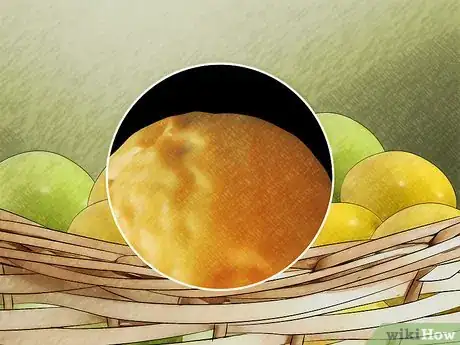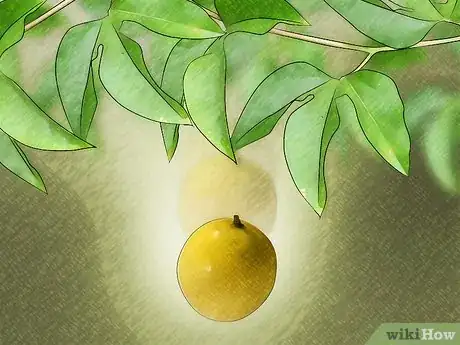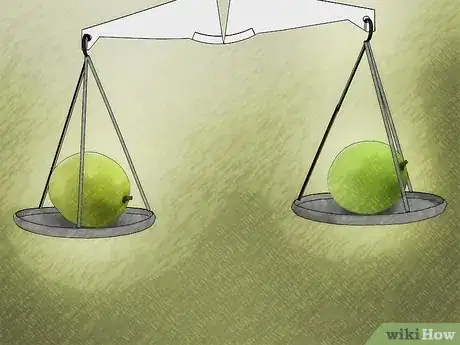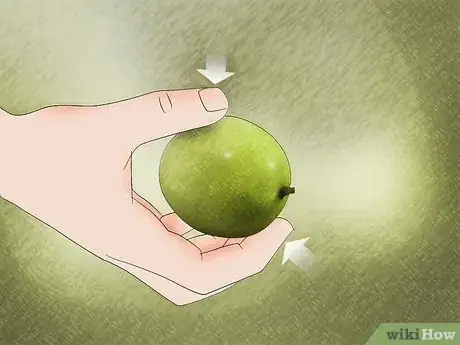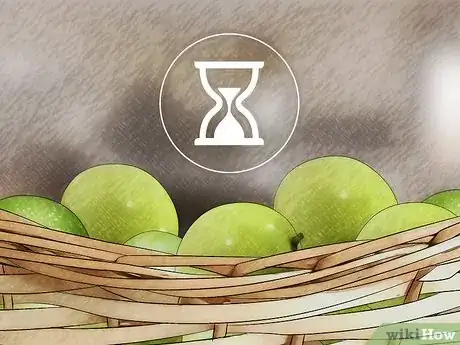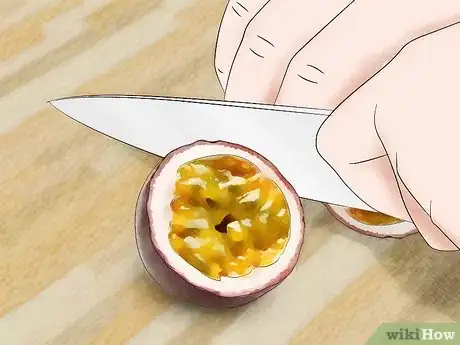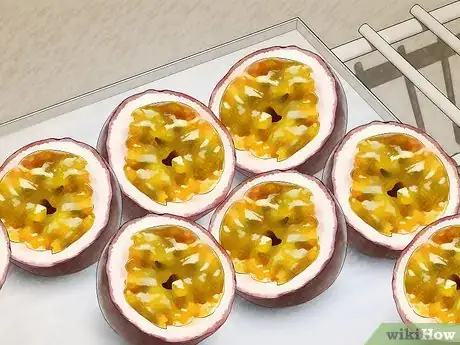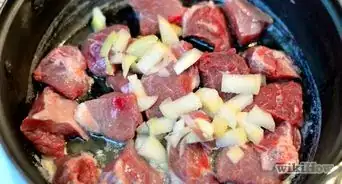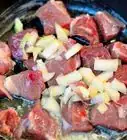This article was co-authored by wikiHow Staff. Our trained team of editors and researchers validate articles for accuracy and comprehensiveness. wikiHow's Content Management Team carefully monitors the work from our editorial staff to ensure that each article is backed by trusted research and meets our high quality standards.
There are 8 references cited in this article, which can be found at the bottom of the page.
wikiHow marks an article as reader-approved once it receives enough positive feedback. In this case, 95% of readers who voted found the article helpful, earning it our reader-approved status.
This article has been viewed 374,196 times.
Learn more...
Passion fruit can be a little deceptive when you’re trying to judge its ripeness, since it starts to look old and wrinkled before it’s ready to eat. However, if you know what to look for and give it a feel in your hand, you can find that one that’s just right. And if you’re out shopping and can’t find one that’s ready to eat this minute, you can always find one that’s almost there and let it ripen at home.
Steps
Knowing What to Look For
-
1Recognize mature fruit by color. Avoid green passion fruit. Remember: the greener it is, the less ripened it is. This holds true for all varieties. Spot ripening fruit by changes in color. Look for fruit that has turned purple, red, and/or yellow.[1] Expect some to be a uniform shade and others to be a mix between colors.[2]
- Some fruit may actually ripen without changing color that much. If you’re growing your own and find green fruit that has fallen from the tree, judge it by other methods before discarding.
-
2Inspect the skin’s texture. Spot unripened fruit by its smooth skin. Recognize ripe fruit by its wrinkles and dimples. Favor moderately wrinkled fruit over excessively wrinkled. Expect very wrinkled fruit to have already passed the peak of freshness.[3]Advertisement
-
3Inspect for damage. Expect to find small cuts and spots, which is normal and generally okay on their own.[4] Bruised fruit is also perfectly edible, just softer. However, do check bruised areas for any cuts through the skin, since the bruised fruit underneath is more at-risk to mold.[5]
- Bruised or moldy portions can be trimmed from the rest.
- Mold that appears on the outside of intact skin can be washed away since you aren't eating the skin.[6]
Judging by Weight and Touch
-
1Let growing fruit fall on their own. If you are selecting fruit directly from a tree, don’t pick them. Let gravity do the work. Expect ripe fruit to fall on their own due to their increased weight.[7]
- However, unripened fruit may also fall due to weather or if the tree is weak from dehydration. Double-check its ripeness by other methods before eating.
-
2Choose heavy fruit. Weigh it in your hand. Recognize immature fruit by its lightness.[8] Favor those that feel heavier than you would expect based on their size.[9]
- A mature passion fruit should be between four and eight centimeters in diameter and weigh between 1.2 and 1.8 ounces (35 and 50 g).[10]
-
3
Ripening, Cutting, and Storing Your Passion Fruit
-
1Ripen at room temperature. If you have fruit that is almost but not quite there yet, give it a few days to ripen further. Leave it sitting out at room temperature, away from direct sunlight.[14] Inspect it daily so you can enjoy before it becomes too wrinkly, at which point it starts to dry out inside.[15]
-
2Cut it open. Do not eat the skin. Use a knife to cut open it. To eat it as is, slice off the top and use a spoon as though you were eating from a bowl.[16] To add it as an ingredient to another dish, slice it in half so you can spoon it out more easily.[17]
-
3Store opened fruit in the fridge or freezer. Once you have cut it open, refrigerate or freeze your fruit to keep it from spoiling. Expect refrigerated fruit to last a week at most. For longer storage, seal it in a high-quality freezer bag and freeze it, which will preserve it up to twelve months.[18]
Community Q&A
-
QuestionCan green passion fruit be picked?
 Community AnswerYes, but a green passion fruit is not ripe. Wait until it gets purple and then pick it if you want one that's more tart. If you want a sweeter fruit, wait until it drops. Do not wait too long though or insects will eat it.
Community AnswerYes, but a green passion fruit is not ripe. Wait until it gets purple and then pick it if you want one that's more tart. If you want a sweeter fruit, wait until it drops. Do not wait too long though or insects will eat it. -
QuestionCan children eat seeds inside passion fruit?
 Community AnswerYes, they are edible and safe for children.
Community AnswerYes, they are edible and safe for children. -
QuestionCan I eat the skin of a passion fruit?
 Community AnswerNo. The skin contains compounds that can form cyanide in your body. Do not eat the skin.
Community AnswerNo. The skin contains compounds that can form cyanide in your body. Do not eat the skin.
References
- ↑ http://www.foodreference.com/html/artpassionfruit.html
- ↑ http://www.familydoctormag.com/healthy-side-dishes-and-snacks/1532-passion-fruit-nutrition-storage-how-to-pick-and-eat.html
- ↑ http://foodandtravel.com/food/in-season/passion-fruit
- ↑ http://www.nutrition-and-you.com/passion-fruit.html
- ↑ http://www.slate.com/articles/health_and_science/explainer/2013/01/bruised_fruit_is_it_safe_to_eat.html
- ↑ http://www.foodreference.com/html/artpassionfruit.html
- ↑ http://gardendrum.com/2012/08/23/growing-passionfruit/
- ↑ http://www.sparkpeople.com/resource/perfect_prod_detail.asp?ppid=71
- ↑ http://foodandtravel.com/food/in-season/passion-fruit
- ↑ http://www.nutrition-and-you.com/passion-fruit.html
- ↑ http://foodandtravel.com/food/in-season/passion-fruit
- ↑ http://www.sparkpeople.com/resource/perfect_prod_detail.asp?ppid=71
- ↑ http://www.familydoctormag.com/healthy-side-dishes-and-snacks/1532-passion-fruit-nutrition-storage-how-to-pick-and-eat.html
- ↑ http://fruitguys.com/almanac/2012/07/02/fresh-fruit-storage-and-ripening-tips
- ↑ http://foodandtravel.com/food/in-season/passion-fruit
- ↑ http://foodandtravel.com/food/in-season/passion-fruit
- ↑ http://www.foodreference.com/html/artpassionfruit.html
- ↑ http://www.familydoctormag.com/healthy-side-dishes-and-snacks/1532-passion-fruit-nutrition-storage-how-to-pick-and-eat.html
About This Article
If you’re not sure how to tell if a passion fruit is ripe, examine the color. A passion fruit that is still green is probably not ripe, whereas purple, red, or yellow fruit probably is. Next, check the surface of the fruit. Ripe passion fruit will have a wrinkled skin, but unripe passion fruit will be smooth. You can also compare the ripeness of 2 fruits by weighing them in your hands. The more mature fruit will feel heavier. For tips on ripening a passion fruit, read on!
